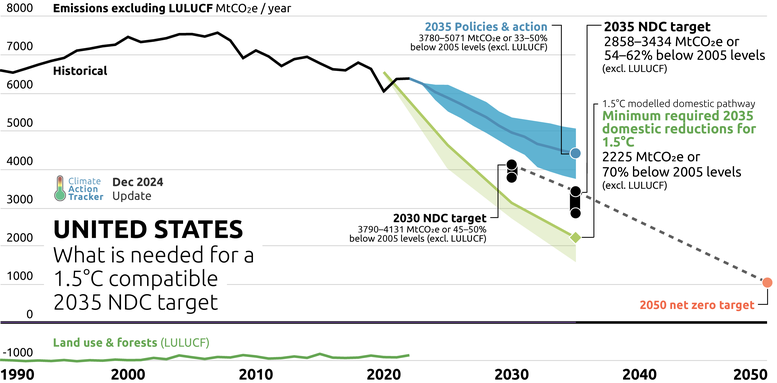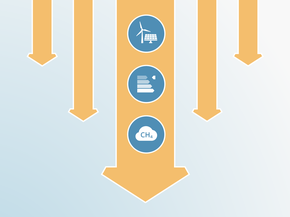2035 NDC
2035 NDC Target Overview

The Trump Administration’s move to exit the Paris Agreement will effectively annul the 2035 climate target submitted by the Biden Administration in late 2024. More importantly and more materially, the Trump Administration’s actions to dismantle policies and rescind funding for climate change mitigation means that limiting peak global warming to 1.5°C will be even more challenging and will require other countries to make more rapid and even deeper emissions reductions. The Trump Administration’s climate agenda is seriously risking a high, multi-decadal overshoot of the Paris Agreement’s long-term 1.5°C temperature limit, even if a future US administration strengthens its targets and actions.
The 2035 NDC submitted by the Biden Administration can still act as a guide for subnational and non-state entities to continue climate action in the US, even as the Trump Administration has initiated the process to formally withdraw from the Paris Agreement. However, it should be noted that the Biden era 2035 climate target is not 1.5˚C aligned. Therefore, subnational actors seeking to advance Paris-aligned action must go beyond this target and its measures.
The Biden Administration's NDC sets a 2035 target of reducing net greenhouse gas emissions by 61–66% below 2005 levels. The target covers all sectors and all gases. The CAT, which excludes emissions from land use, land use change and forestry (LULUCF), finds that the target results in 2,900–3,400 MtCO2e in 2035. This target is not 1.5°C-compatible against modelled domestic pathways: a 1.5°C compatible emissions level, excluding LULUCF, would be 2,200 MtCO2e in 2035.
At the time the Biden Administration submitted the NDC, the Bipartisan Infrastructure Law (BIL) and the Inflation Reduction Act (IRA) were the central federal mechanisms for driving emission reductions towards the 2035 target. However, under the CAT's current policy projections—which consider the impact of the BIL and IRA and were developed before the Trump Administration took office—the US will not reduce emissions fast enough to reach the 2035 target.
To reach the Biden Administration’s target, the US government would have needed to implement new, additional climate policies and actions; an outlook that the Trump Administration has rendered unlikely, as it has already taken executive actions to repeal existing climate policies, including the BIL and IRA, limit federal funding for climate action, and expand fossil fuel production.
The Biden Administration worked in close collaboration and cooperation with subnational actors in state, territorial, Tribal, and local governments to develop the 2035 target. If the Trump Administration continues to obstruct and undo climate policies, subnational and non-state actors need to slow the impact of the federal rollback of climate policies by strengthening climate action at the subnational level.
| USA | 2035 NDC TARGET | |
|---|---|---|
| 2035 NDC target | ||
|---|---|---|
| Formulation of target in NDC |
An economy-wide target of reducing its net greenhouse gas emissions by 61–66 percent below 2005 levels in 2035. [61–66% below 2005 levels by 2035 (incl. LULUCF)] |
|
|
Absolute emissions level in 2035 excl. LULUCF |
2,858–3,434 MtCO2e [48–57% below 1990 or 52–60% below 2010] |
|
| Status | Submitted on 19 December 2024 | |
Ambition
For the world to have a significant chance of limiting warming to 1.5˚C, governments must switch to emergency mode and strengthen both their 2030 targets and current policies to include substantial emissions cuts and significantly contribute to closing the 2030 emission gap. The US’ submitted 2035 NDC target did not increase the ambition of its 2030 target.
2030 NDC Target
| 2030 NDC target | ||
|---|---|---|
| Is the target 1.5°C compatible with modelled domestic pathways? |
|
|
| Is the target 1.5°C compatible with fair share? |
|
|
| Is this a stronger target? |
|
|
2035 NDC Target
| 2035 NDC target | ||
|---|---|---|
| Is the target 1.5°C compatible with modelled domestic pathways? |
|
|
| Does the NDC include sectoral targets? |
|
|
| Does the NDC include a renewable energy capacity target? |
|
|
| Does the target align with the country’s net-zero pathway? |
|
|
The submitted NDC of 2,900–3,400 MtCO2e in 2035 is not 1.5°C compatible against modelled domestic pathways because it is above the 1.5°C compatible threshold. To be 1.5°C compatible against modelled domestic pathways, the US would need to reduce its emissions, excluding LULUCF, to 2,225 MtCO2e in 2035. The 2035 NDC does not increase the 2030 NDC target’s ambition.
The US 2035 economy-wide target does not include specific sectoral plans and targets. The NDC does outline the key federal policies in the power, buildings, transport, industry, agriculture, and forestry sectors that were expected to drive emissions reductions towards the 2035 target. The Inflation Reduction Act (IRA) and the Bipartisan Infrastructure Law (BIL)—both of which were developed by the Biden Administration and were introduced after the US 2030 NDC submission—are described as the principal national-level policies for achieving the 2035 target. The BIL aims to expedite the development and implementation of clean energy infrastructure. The IRA is intended to mobilise unprecedented public and private investment in clean energy production. In combination, the BIL and IRA were planned to incentivise and accelerate climate action across the US economy and, since their introduction, have already reduced emissions.
It is important to note that the future of both the BIL and IRA is uncertain. The Trump Administration has already taken executive action to freeze federal funding under both laws, and has signalled that it will try to roll back certain components. While the Trump Administration cannot use executive action to unilaterally repeal either the BIL or IRA, Republican majorities in the House and in Congress may be supportive of and carry out the administration’s agenda. As of October 2024, Republicans voted 53 times in the House and once in the Senate to repeal certain climate provisions in the IRA since its introduction in 2022.
The NDC explicitly draws attention to the US federal governance structure and highlights the importance and capacity of state and other subnational governments to contribute towards the 2035 target. State governments are especially well-positioned to reduce emissions in the power, transport, and buildings sectors. However, if the Trump Administration, with support from the Republican majority in both the House and Congress, permanently restricts funding or reverses regulations for the BIL and IRA’s implementation, it is unclear whether subnational entities would be able to make up the lack of federal funding and policies.
The 2035 NDC does not include a renewable energy capacity target. Instead, the document references the US power sector target of generating 100% “clean,” “carbon pollution-free" electricity by 2035. This target is not—and should not be—conflated with a renewable energy target. The target’s formulation allows the government to use fossil energy with carbon capture and sequestration (CCS), as well as nuclear and biomass energy, to achieve the target. The NDC cites the current share of renewable energy generation, which has more than doubled over the past decade; in 2023, renewables generated 21% of the US electricity.
The NDC claims the 2035 target is fully aligned with its net zero pathway; it argues that “the entire 2035 range is on a straight line or steeper trajectory to net zero emissions by 2050 for all greenhouse gases.” To achieve its net zero target, the CAT estimates the US needs to reduce emissions to 558–1,540 MtCO2e or 80-93% below 2005 levels in 2050, excluding LULUCF. Assuming the US realises its 2030 NDC target, the 2035 NDC target is aligned with the median net zero pathway, but not the pathway’s uppermost bound. Further information on the US net zero target can be found here.
The NDC explicitly refers to the outcomes of the first Global Stocktake. The NDC outlines targets, measures, and metrics that correspond with some of the Global Stocktake’s sectoral goals. Highlights include references to the US expansion of renewable energy generation, the rate of electrification and energy efficiency improvements, the adoption of zero- and low-emissions vehicles, and the commitment to halting and reversing deforestation by 2030. It is important to note that the US does not commit to phasing out either fossil gas or coal.
Fairness & Finance
Developed countries need to significantly scale up international climate finance and other means of support. Developed countries should set 1.5°C aligned domestic mitigation targets in their NDCs and communicate the financial and other support they will provide to developing countries.
| 2035 NDC target | ||
|---|---|---|
| Does the target clearly communicate the climate finance contributions and other support to be provided and mobilised to other countries? |
|
|
In its 2035 NDC, the US does not acknowledge its responsibility, nor communicate its intention to provide and mobilise climate finance to other countries. The US did not do so in its 2030 NDC either. Developed countries, like the US, are expected to complement their domestic mitigation efforts with significant financial support for mitigation in other countries.
Our methodology makes it clear that developed countries should set NDC targets that are at least compatible with their 1.5°C modelled domestic pathways and should meet these targets within their own borders and using their own resources. The US submitted 2035 NDC is not 1.5°C compatible against modelled domestic pathways.
Credibility
Credible NDCs should build on robust national planning processes that translate the economy-wide emissions reductions target into action in all sectors. Governments need to ramp up the implementation of their existing targets and further develop policies to close the still significant emissions gap between current policies and 1.5°C. Contradictory policies must be addressed and reversed: fossil fuel production needs to be phased out, while fossil fuel exploration and fossil fuel subsidies need to stop.
| 2035 NDC target | ||
|---|---|---|
|
Is the target aligned with current policies AND driving more ambitious action? |
|
|
| Does the NDC reference national planning processes for its development? |
|
|
|
Does the NDC reference an institutional framework/plan in place for its implementation? |
|
|
|
Does the target commit to phase out fossil fuel production? |
|
|
| Does the target commit to stop fossil fuel exploration & subsidies? |
|
|
The US 2035 NDC details the planning processes behind the target’s development and the existing measures for its implementation. However, the CAT finds that the US would need to go beyond the Biden Administration’s policies and actions and enact new measures to reach the 2035 target. The Trump Administration has vowed to reverse the Biden Administration's course on climate action and has already taken executive action to undermine many of the policies that underpin the NDC. The administration’s initiation of the US withdrawal from the Paris Agreement essentially voids the NDC, and the administration's actions entirely compromise the target’s credibility.
The US needs to implement new, additional climate policies and actions to reach its 2035 target, as current policies are insufficient. The CAT estimates that existing policies will reduce emissions by 33–50% below 2005 levels in 2035, emitting 3,780–5,071 MtCO2e in 2035, well below a 1.5˚C compatible level of 2,225 MtCO2e.
The 2035 NDC’s development was coordinated and managed by the Biden Administration’s White House Climate Policy Office. Central to the target’s development was a bottom-up analysis of existing and possible policies at the national, subnational, and non-state level.
The revision was drafted in consultation and cooperation with a broad, diverse coalition of state, territorial, Tribal, and local governments, as well as workers unions, private sector representatives, civil society organisations, and higher education institutions. In doing so, the NDC acknowledges the important role of subnational and non-state climate action.
While the NDC highlights the importance of subnational and non-state climate action, it also identifies national-level policies that are key to the realisation of the 2035 target. The BIL and IRA are described as “the backbone of the suite of existing federal legislation and investments that are contributing to the achievement the 2035 NDC target.” However, the future of these policies is uncertain. The Trump Administration has signalled that it will try to eliminate components of the BIL and IRA and has also initiated processes to reverse emissions standards in the power and transport sectors; the standards that were strengthened under the Biden Administration and are cited in the NDC as important components for realising the 2035 target.
In its NDC, the US does not commit to discontinuing fossil fuel exploration, production, or subsidies. The US is the world’s largest producer of crude oil and fossil gas. Since 2022, the US is the world’s largest exporter of liquified natural gas (LNG). The US government continues to heavily subsidise fossil fuels: in 2023, fossil fuel subsidies totalled nearly USD 15bn. The US plans to expand oil and gas production and increase LNG exports. The US Energy Information Agency’s (EIA) most recent projections of the US energy market forecast that fossil gas production will increase by 15% and LNG exports will increase by 152% between 2022 and 2050. As the world’s largest fossil fuel producer and LNG exporter, as well as one of the largest emitters in the world, the US has a responsibility to take ambitious action to phase out fossil fuels.
Transparency
Governments should set absolute, economy wide, emissions reductions target trajectories including all GHG gases, specifying the emissions levels for each year as an absolute level of emissions (excluding LULUCF) to ensure they are clear, transparent, and immune to creative accounting. NDC targets should primarily focus on their domestic reductions by decarbonising all sectors of the economy rather than relying on forestry sinks, other carbon dioxide removal (CDR) or international carbon markets.
| 2035 NDC target | ||
|---|---|---|
|
Is the target based on fixed, absolute values? |
|
|
|
Does the target cover all sectors? |
|
|
|
Does the target cover all greenhouse gases? |
|
|
|
Does the target specify an emissions pathway? |
|
|
|
Does the target separate out land use and forestry? |
|
|
|
Does the target separate out other CO2 removal by type? |
|
|
|
Does the target separate out the use of carbon credits? (Article 6) |
|
|
The US 2035 NDC target is not based on an absolute value. Instead, the target is formulated as a percentage reduction below 2005 levels.
The NDC target covers all sectors, including land use, land use change and forestry (LULUCF). The NDC does not break down the economy-wide target by sector. As a result, it is unclear how each sector would contribute to meeting the target. The inclusion of the LULUCF sector’s emissions, which are uniquely challenging to account for, undermines the target’s transparency.
The target considers all greenhouse gas emissions, but does not set targets for specific greenhouse gases. However, the NDC anticipates a reduction of methane emissions of at least 35% below 2005 levels in 2035. The NDC also forecasts “significant emissions reductions from other non-carbon dioxide super pollutants.”
The 2035 NDC does not define a specific emissions pathway, claiming “the NDC is built on the premise that there are multiple pathways to achieving the expected level of emissions reductions.” The NDC does not provide any further clarification on the number of and differences between pathways.
In the NDC, the US does not transparently communicate the intended or expected contribution of the carbon dioxide removals (CDR) or carbon markets. The NDC leaves the door open for the use of contentious voluntary carbon markets under Article 6 of the Paris Agreement; the NDC notes, in the case that the US relies on carbon markets to achieve its target, the government would appropriately report the use of such market mechanisms.
For more information, on US climate targets and policies, please click here. For the CAT’s full recommendations for setting NDC targets that form the basis of the analysis above, please click here.
Further analysis
Latest publications
Stay informed
Subscribe to our newsletter




